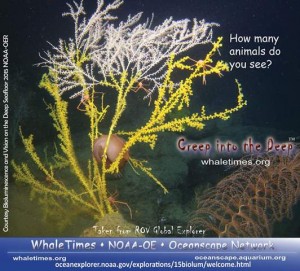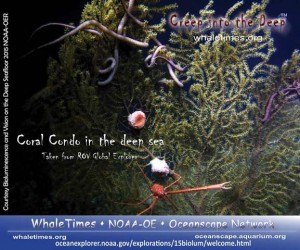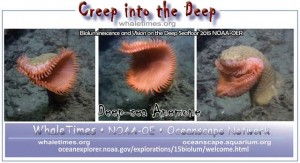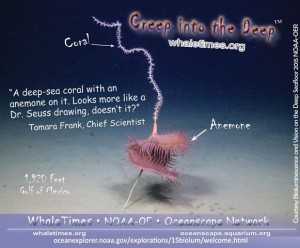If coral builds it…they will climb. How many critters do you see in these photos. Remember, plants do not grow in the deep, so if it may look like a plant but it’s an animal!
Monthly Archives: July 2015
Elusive Giant Isopod
Dear Virtual Science Team,
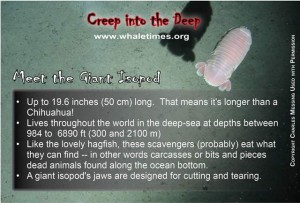 Though we hoped to see many giant isopods so we could learn more about their vision. So far they have eluded us. Maybe on the next ROV dive or maybe the Medusa secretly videoed them dancing and singing after the ROV left! Wouldn’t that cool?
Though we hoped to see many giant isopods so we could learn more about their vision. So far they have eluded us. Maybe on the next ROV dive or maybe the Medusa secretly videoed them dancing and singing after the ROV left! Wouldn’t that cool?
Tammy
Dr. Tamara Frank
Chief Scientist and Deep-Sea Explorer
Creep into the Deep Mission:
Bioluminescence and Vision on the Deep Seafloor 2015 Expedition, NOAA-OER
Anemone faces?
The Medusa
Hello Virtual Science Team,
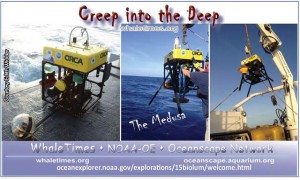 Today is the fifth day of our cruise and the Medusa is on her second drop. This is the first time for the Medusa to be in the Gulf of Mexico. The Medusa is a camera system designed to explore the deep sea in a new way – one that focuses on attracting animals instead of scaring them away. I became interested in a different way of exploring after many years of diving in submersibles and using Remote Operated Vehicles (ROVs). Both convinced me that animals were avoiding the bright lights and noisy thrusters on these standard exploration platforms.
Today is the fifth day of our cruise and the Medusa is on her second drop. This is the first time for the Medusa to be in the Gulf of Mexico. The Medusa is a camera system designed to explore the deep sea in a new way – one that focuses on attracting animals instead of scaring them away. I became interested in a different way of exploring after many years of diving in submersibles and using Remote Operated Vehicles (ROVs). Both convinced me that animals were avoiding the bright lights and noisy thrusters on these standard exploration platforms.
My solution was a camera platform that was quiet and that could see without being seen by illuminating with red light that is invisible to most deep sea animals and that used an optical lure. 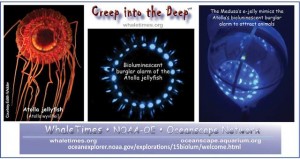 What’s an optical lure? It’s a ring of dim blue lights that imitates the bioluminescent burglar alarm display of a deep-sea jellyfish. The burglar alarm might startle the predator and entice bigger predators to swoop in for a quick meal of the would-be predator. When the e-jelly on the Medusa lights up, it lures animals closer so we can capture them on video.
What’s an optical lure? It’s a ring of dim blue lights that imitates the bioluminescent burglar alarm display of a deep-sea jellyfish. The burglar alarm might startle the predator and entice bigger predators to swoop in for a quick meal of the would-be predator. When the e-jelly on the Medusa lights up, it lures animals closer so we can capture them on video.
It has been remarkably successful and has recorded some amazing things including the first video ever recorded of a giant squid in the deep sea! We probably won’t see any giant squid on this mission but I’m always hopeful that we’ll see something completely new and exciting.
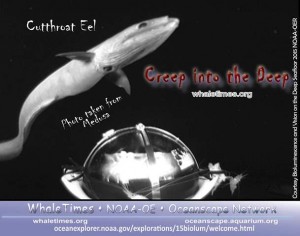 Here is a photo from its first deployment on this cruise, a very cool eel.
Here is a photo from its first deployment on this cruise, a very cool eel.
It’ll be exciting to find out what else the Medusa saw in the deep!
Cheers,
Edie
Dr. Edith Widder
Marine Biologist and Deep-Sea Explorer
Creep into the Deep Mission:
Bioluminescence and Vision on the Deep Seafloor 2015 Expedition, NOAA-OER
Tusk, horn, or clam?
Hi Virtual Science Team,
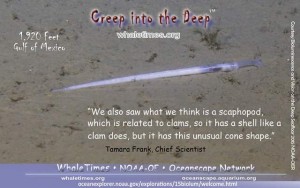 Our Global Explorer ROV happened upon this We also saw what we think is a Scaphopod. This odd-looking creature is related to a clam, so it has a shell like a clam does. But it has this unusual cone shape. Because it’s shaped like a tusk, it’s also called a tusk shell. Usually, they’re found buried in the sediment (dirt), with the narrow end up, but this little thing was moving along, dragging its huge shell behind it. We never did figure out why it didn’t like the section of mud that it was already on. I guess that’s an advantage of having your home on your back. You can pick up and move if you don’t like the neighborhood!
Our Global Explorer ROV happened upon this We also saw what we think is a Scaphopod. This odd-looking creature is related to a clam, so it has a shell like a clam does. But it has this unusual cone shape. Because it’s shaped like a tusk, it’s also called a tusk shell. Usually, they’re found buried in the sediment (dirt), with the narrow end up, but this little thing was moving along, dragging its huge shell behind it. We never did figure out why it didn’t like the section of mud that it was already on. I guess that’s an advantage of having your home on your back. You can pick up and move if you don’t like the neighborhood!
Tammy
Dr. Tamara Frank
Chief Scientist and Deep-Sea Explorer
Creep into the Deep Mission:
Bioluminescence and Vision on the Deep Seafloor 2015 Expedition, NOAA-OER
Dr. Seuss’s inspiration?
Weird but true…it’s a fish
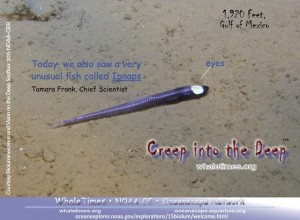 Hi Virtual Science Team,
Hi Virtual Science Team,
Our Global Explorer ROV happened upon this very unusual fish called Ipnops. Those two bright yellow patches on the top of its head are its eyes. It doesn’t have lenses, because those cut out too much light. Basically, the eyes are naked retinas, with a layer of reflecting pigment below them, which is what gives it them that yellowish glow when you shine a light on it.
Tammy
Dr. Tamara Frank
Chief Scientist and Deep-Sea Explorer
Creep into the Deep Mission:
Bioluminescence and Vision on the Deep Seafloor 2015 Expedition, NOAA-OER
Let’s not Trash the Sea
Dear Virtual Science Team,
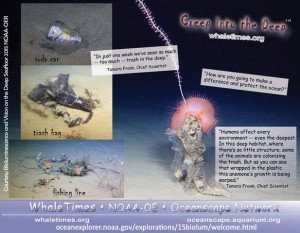 We’ve seen so many exotic and amazing creatures it makes me smile just thinking about them. As you know, the deep is a very important home to so many mysterious and marvelous animals.
We’ve seen so many exotic and amazing creatures it makes me smile just thinking about them. As you know, the deep is a very important home to so many mysterious and marvelous animals.
Some moments, though, cause my smile to fade. At the deepest depths, we see trash. Human created garbage mars the beauty even at the great depths where we’re studying, 6,562 feet (2,000 m).
At this deepest habitat, where there’s so little structure, some of the animals try to colonize on the trash. But as you can see with the anemone wrapped in the plastic, its growth is being warped. We saw fishing line, soda cans, trash bags, and even a big oil barrel.
Now that you’ve helped us explore the deep, you have an important job. Help us keep it clean.
Many people do not realize that everything they do on land affects the deep — from not properly disposing of trash to not monitoring invisible pollutants such as chemicals like the detergents, fertilizers, cars, and other products we use all the time.
How can you help? It’s easy to make a difference. Reduce, reuse, and recycle. Be aware of the products you use that might run from your home, lawn, or driveway into storm drains an into streams and rivers. It all makes it to the ocean.
What do you think you can do to help us protect the deep sea?
Tammy
Dr. Tamara Frank
Chief Scientist and Deep-Sea Explorer
Creep into the Deep Mission:
Bioluminescence and Vision on the Deep Seafloor 2015 Expedition, NOAA-OER
Glass Sponge
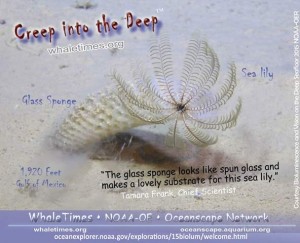 Hello from the Gulf of Mexico. The research cruise is going great and the ROV dives successful. Here are a couple more gorgeous creatures we found today at 1920 feet.
Hello from the Gulf of Mexico. The research cruise is going great and the ROV dives successful. Here are a couple more gorgeous creatures we found today at 1920 feet.
I just love this glass sponge. It is so beautiful, like spun glass. With the sea lily on top, it looks like such a delicate flowering plant. A sea lily is in the same group as seastars and sea urchins. In a world with very little substrate (stuff on the ground), the sponge makes a lovely substrate for a sea lily.
As we were collecting the glass sponge, we saw yellow things inside. We asked the ROV pilot to tip the claw towards us (the camera) so we could see what they were. They were tiny amphipods (relatives of shrimp). These glass sponges always seem to have amphipods or shrimp associated with them. Often, the spicules of the sponge close off the opening. The shrimp (sometimes a pair of male and female) are trapped inside. They do quite well because they’re filter feeders like the sponge. The sponge is in the right position to capture food carried by the current, which means the amphipods inside can too.
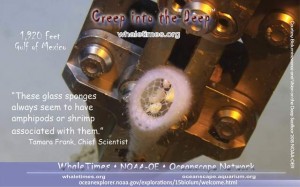 In some cultures, the glass sponge and the mating pair of crustaceans inside, are dried and given as a wedding gift as a sign of everlasting love. It’s called a Venus Flower Basket.
In some cultures, the glass sponge and the mating pair of crustaceans inside, are dried and given as a wedding gift as a sign of everlasting love. It’s called a Venus Flower Basket.
I wonder what we’ll find on our next dive!
Cheers
Tammy
Dr. Tamara Frank, Chief Scientist and Deep-sea Explorer
Vision and Bioluminescence in the Deep-sea Benthos II, NOAA Ocean Exploration
Meet the giant isopod
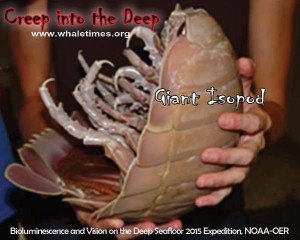 Hello Virtual Science Team Members and friends,
Hello Virtual Science Team Members and friends,
This is a giant isopod, a deep-sea scavenger about the size of a small dog. Does it look familiar? It might. Perhaps you’ve seen one in your backyard. Well, not as big as this, but a much, much, much smaller version. It’s a distant relative of the giant isopod. You might call it a roly-poly or a pill bug. it eats rotting fish or animal carcasses it finds on the ocean floor. Yum!
Not only is the giant isopod a delightful critter with an unusual diet, it has fascinating eyes. Our Creep into the Deep Science Team is studying both bioluminescence and vision in the deep. The science team wants to learn more about these incredible creatures and how they survive in the darkest deepest parts of the sea. They suspect that the giant isopod’s slow compound eyes help it see the dim mats of bioluminescent bacteria that dust the ocean floor. We can’t wait to learn more, too!
The Oregon Coast Aquarium’s Oceanscape Network created a fun video for you. Enjoy!
Jake, the SeaDog
Video courtesy of the Oregon Coast Aquarium’s Oceanscape Network
Read more about the Creep Into The Deep Science Team (pdf)
Meet our Creep into the Deep Science Team
Watch other videos about the deep ocean.
Follow the Creep into the Deep Mission
